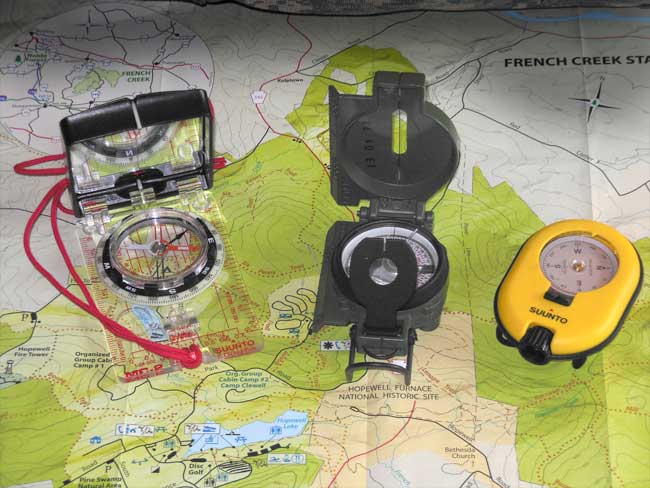
From how carefully we plot our lines on the map to how well we can maintain a straight track while driving off-road, the smallest errors can add up quickly. Being able to accurately sight with a compass will be critical, which is why we took three different compasses for a comparative field test.
As we’ve been training on land navigation a lot lately, we have come to realize that the compasses don’t seem as “precise” as we had imagined. For example, if we move just slightly and point at the same “target” the heading changes by a few degrees — and a few degrees of difference can put us kilometers off over a long distance!
The three compasses I am working with today have all been recommended by land navigation professionals and/or experienced Gazelle rally competitors. They are all excellent choices, but I am trying to determine which one will be more comfortable for us.
Cammenga U.S. Military Lensatic Compass: A lensatic compass differs from the traditional “orienteering” compasses most hikers are familiar with. It’s design is preferred by military forces because of its precision and durability. It allows the user to take hyper-accurate bearings for land navigation and directing artillery fire. Functional from -50ºF to +150ºF, it is also water- and sand-proof, and has a luminous dial to allow for navigation in low-light conditions and at night. The “deep-well” construction means it can be used globally with little or no effect in accuracy caused by a tilting compass dial.
We liked this compass best for accurate sighting of azimuths to or from specific terrain features in the field, though we found it less convenient for tracking to a desired heading.
Suunto MC-2 Global Compass: This compass is designed to be used anywhere in the world and has the added advantage of an adjustable declination. It is highly accurate and reliable and combines the best features of a sighting compass with the baseplate format familiar to orienteers.
We found this compass best for tracking to a desired heading, because you can simply “dial in” the azimuth you want, and it remains in place, so you do not have to worry about remembering it as you get more fatigued. We also like the way it works easily for plotting routes directly on the map because of the adjustable declination. The only area we had trouble with was precision sighting — we found it more difficult to consistently get the “exact” same azimuth reading with this compass, depending on how we looked at it, we could be a degree or two off.
Suunto KB-20/360/R Sighting Compass: This professional sighting compass is designed for advanced navigational scenarios where great precision is needed in challenging conditions. This viewfinder compass is accurate to within half a degree.
We felt this compass was definitely the standout when it comes to accurate sighting, as it gives you the exact degree number very clearly lined up in a viewfinder, with no room for interpretive error. However, like the military compass, this one has no way to “dial in” a heading that you can easily track. And it doesn’t have a baseplate or other straightedge that you can use to easily plot a route on a map.
There was no clear “winner” in this “test,” though the MC-2 is slightly better for general use because of the ease of plotting and tracking with it. We will take all three with us for the Rally, so that we can go back and forth between them as needed. And this way we will be sure to have a few “back up” compasses in case we lose or break one during the competition!